Forging a Master Plan towards a
Sustainable Rural Transformation
in the Region
AsiaDHRRA 2021-2022 Biennial Report
Chairperson's Message
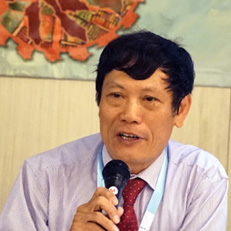
I want to thank the DHRRAs, the ExeCom members of the period 2018-2023, and all the DHRRA family for your trust. It’s really been a privilege for me to be a Chairperson of the AsiaDHRRA network for more than four years.
I tried my best to fulfill the tasks given by our network, and I would like to thank the very dedicated Vice Chairperson and our Secretariat team from 2018 to 2023 for their support, encouragement, and great efforts.
I am happy that our network continues to be sustained, and with a good reputation among the NGOs in Southeast Asia, we have developed a very good partnership with regional and international organizations, friendship, and solidarity.
I would like to wish our network would continue to gain great success and contribute to the sustainable development of agriculture in the region. I will continue to work with VACVINA and VietDHRRA, and I will continue to keep in contact with AsiaDHRRA and DHRRA family, as well as friends, in the future. Thank you very much, and I wish you and your family good health, happiness, and luck.
Dr. Nguyen Xuan Hong
Chairperson (Outgoing)
13th General Assembly
July 4, 2023
via Zoom
The past 2 years in numbers...
Two years in a brief
In late 2020, AsiaDHRRA launched its new five-year Strategic Action Plan with the theme: E-LE-VATE (Elevate-Lead-Innovate) Rural Communities towards Sustainable Territorial Development and Transformation. It is anchored on continuing the significant and concrete gains from the previous strategic planning cycle. At the same time, shifting gears toward responding to the changing developing contexts brought about by the impacts of the COVID-19 pandemic that rushed the digital revolution, worsened global warming, and heightened food and nutrition insecurity.
The last two years have been exhilarating for the network in implementing the new cycle of its strategic plan while navigating through the global COVID-19 pandemic with constrained resources. At the same time, the years 2021-2022 have been invigorating as AsiaDHRRA became the prime mover of the recently adopted ASEAN Master Plan on Rural Development for 2022 – 2026 through the concerted efforts of its leaders, secretariat, DHRRA members, and partners.

Since 2021, our regional programs have been supporting 13 RPOs, reaching at least 11,660 family farmers in four ASEAN countries (Cambodia, Indonesia, Philippines, Vietnam). Support for these RPOs is built on the results of previous organizational and economic development strengthening initiatives of AsiaDHRRA and DHRRAs and is core to the SAP goal of empowering rural peoples’ organizations.
In particular, the Farmers’ Organization for Asia (FO4A) Project with AgriCord, where AsiaDHRRA is an agri-agency member, has been fully operational at FO levels despite redesigning issues to respond to the pandemic. Technical advisories were provided virtually and during field missions in 2022 when travel resumed after a long lock down.
A synergy among FO4A national and local FO partners was also pursued in Cambodia, Indonesia, Philippines, and Vietnam and our 11 partner organizations have developed their organizational capacities guided by the AsiaDHRRA Growth and Development Framework.
It is along FOA implementation that AsiaDHRRA interacts with its strategic FO partner, AFA (Asian Farmers’ Association for Sustainable rural Development), as they implement the twinning component of FO4A for the Asia Pacific Farmers’ Program (APFP), a broad-based platform of FOs across the Asia-Pacific region.

Dialogue with Ngudi Mulyo, a FO4A partner in Indonesia
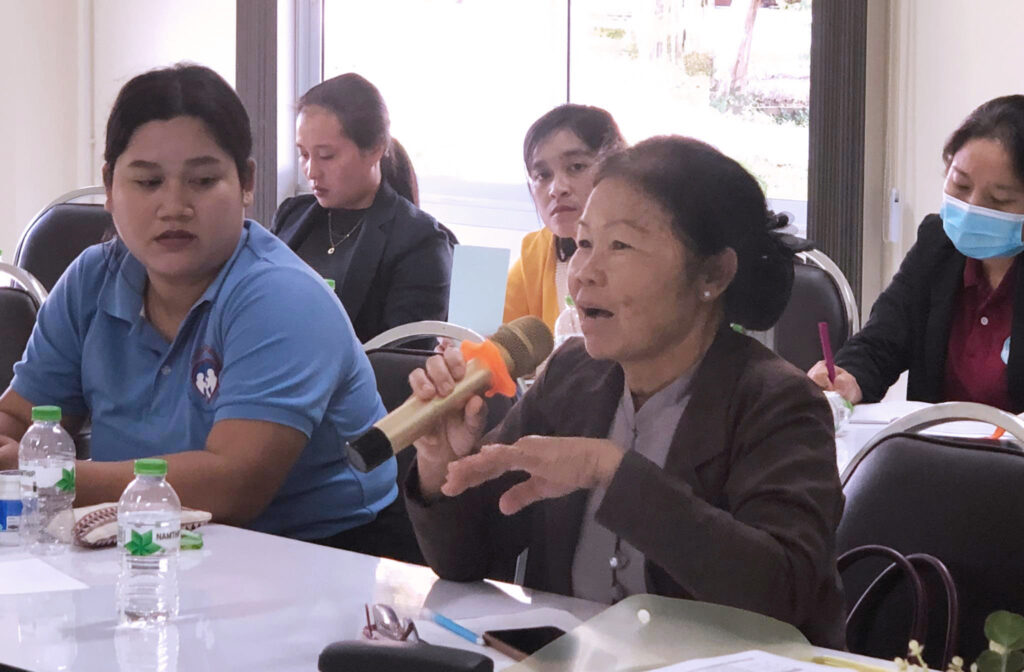
Three FO dialogue events with the government and other stakeholders during the Learning Program (LP) paved the way to increasing women and youth engagement in responsible agri-investments. The Responsible Agriculture Investment (RAI) Learning Program (LP) serves women and youth in the RAI cooperation with the UN Food and Agriculture organization (FAO). The RAI LP was a good model for applying learnings generated towards Constructive Engagement with government and other stakeholders.
Regional and national scoping studies were conducted on gender mainstreaming in ASEAN, Gender, and Youth in RAI, on child labor and migration (CLM), and the UN Decade of Family Farming (UNDFF) Policy Cycle Review with FAO-SEARCA.These research work strengthened AsiaDHRRA’s capacity for data-informed policy and lobby work both at national and regional levels, widening interest from various support-groups.

Under the Digital Village Initiative (DVI) Project with FAO, AsiaDHRRA also conducted a Scoping of the Policy Environment for digital agriculture and a Digital Village Ecosystem Assessment (DVEA) to gauge the preparedness of selected FOs/agricooperatives and their villages for an inclusive digital agriculture uptake. Results of the DVI initiative shall feed into AsiaDHRRA’s effort to raise resources to build upon the interest of selected FOs who have proven preparedness for an uptake of digital solutions and innovation that are responsive and relevant to the context and needs of small-scale farmers and producer organizations.
Case documentation of various on-ground agroecological initiatives in three countries (Cambodia, Philippines, and Vietnam) was conducted under the Farmers’ Organizations’ Leading Research and Innovation (FO-RI) Project of AgriCord, a regional initiative to promote Agroecology with FOS in the driver’s seat.
In late 2022, AsiaDHRRA and PhilDHRRA joined a seven-consortium project on “Rural-Urban Market Link (RUML): Establishing a Mechanism to Promote Inclusive Livehood for the Marginalized sector” supported by USAID, and led by GlowCorp, a partner market intermediation mechanism. The program envisions small scale agricultural producers’ sustainable access to urban markets, in return promoting a steady supply of affordable, safe, and nutritious food, with processes in line with policy environment that benefits marginalized communities, particularly women and youth. To date, AsiaDHHRA, being assigned to focus on the Monitoring, Evaluation, Learning, and Accountability (MEAL) system of the project, has already established the monitoring and evaluation, reporting system and tools that are anchored on a MEAL framework including processes to gather learnings and reflections and development of knowledge products. AsiaDHRRA has initiated assessment of capacities of 4 FOs (out of 10 targets for the year) to meet the market demands. AsiaDHRRA provides advisory to improve FOs link to markets.

The DHRRA network also mobilized institutional partnerships with relevant regional bodies on food, agriculture, rural development, and poverty eradication, and rallied them on the aspiration of transforming ASEAN partnerships toward the formulation and adoption of the first ASEAN Master Plan on Rural Development, sanctioned by during the ASEAN Leaders’ Summit on November 2022.
The last two years also witnessed the network planting seeds toward realizing its new target on empowering rural youth in the agriculture sector, with FAO. Following the regional research on Child Labor and Migration (CLM) in Indonesia, Philippines, and Thailand, it piloted an initiative on Child and Youth Labor in Agriculture (CYLA) in Panukulan, Quezon, Philippines. Results of the study and piloting served as inputs in key policy discussion on the elimination of child labor in the fisheries sector in ASEAN. The value addition by AsiaDHRRA is its ability and orientation to connect CL advocacies with rural development efforts, believing that the root cause of CL is poverty at household and community level. The sector had to be organized for a stronger voice in policy discussions and in embarking on economic activities that will help bail out children, in particular the young youth (15–17-year-old) from oppressive and hazardous labor, together with their farming families.
Through these efforts, our work has consistently contributed to localizing the following Sustainable Development Goals (SDGs) and achieving its targets
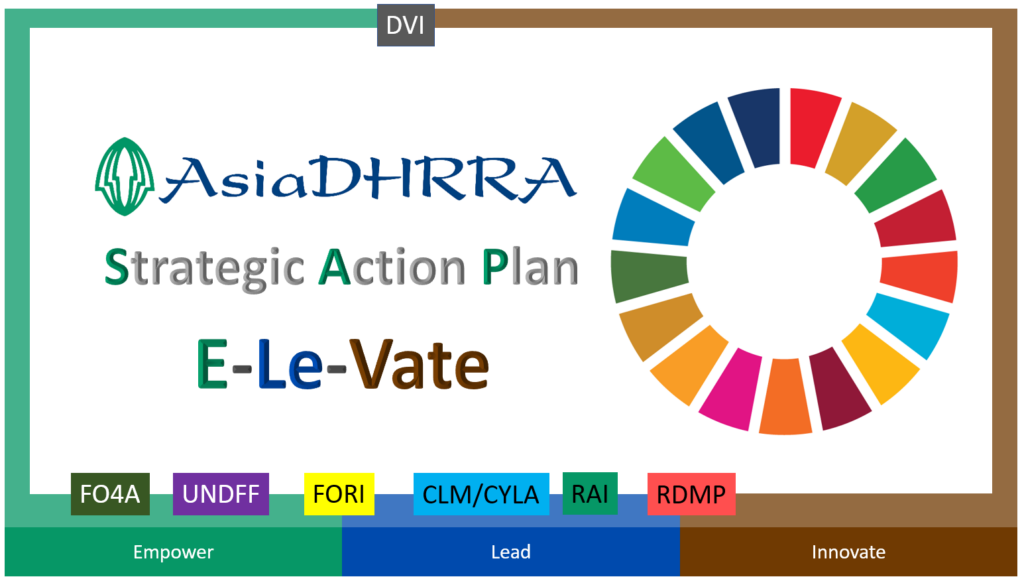

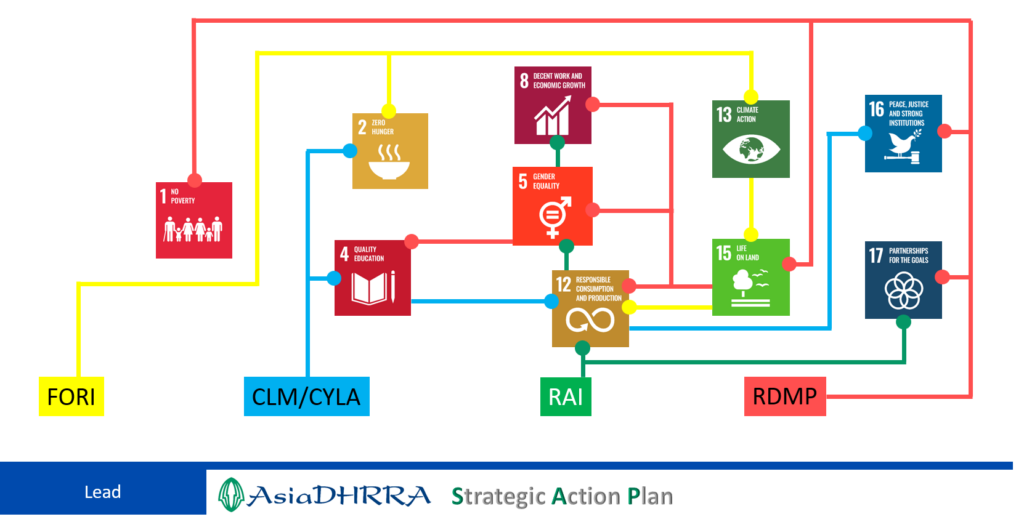
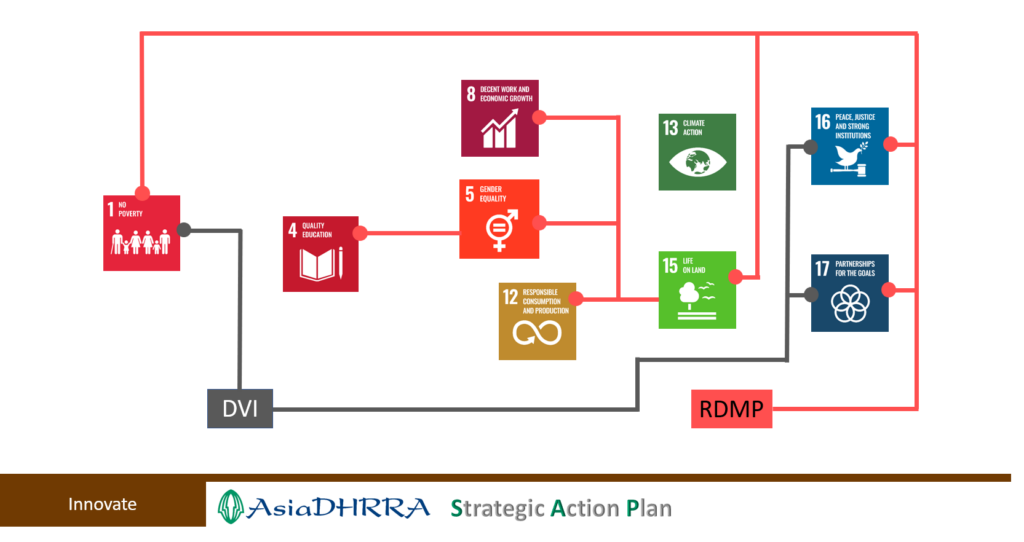
Milestones to Build Upon – to 2025 (SAP), to 2026 (MPRD), to 2030 (SDG)
The 2021-2025 AsiaDHRRA SAP focuses on three outcome areas: Outcome 1 (Empower) centers on strengthening RPOs’ capacities to serve their members and communities effectively; Outcome 2 (Lead) banks on the network’s existing partnerships in contributing to policy-making at different governance levels and capacity development to lead rural development and poverty eradication actions; and Outcome 3 (Innovate) aims toward advancing the network’s governance, competency, and services that are value-based and data-driven.
So far, we are progressing in accomplishing targets in Outcomes 1 and 2, and gaining grounds for achieving Outcome 3.
I. Empowering Rural Peoples’ Organizations
Starting in 2021, AsiaDHRRA has directly supported a lesser number but highly potent RPOs. Sixteen (16) RPOs (see Figure 6) are being supported under its regional programs on Farmers Organizations in Asia (FO4A) and Digital Village Initiative (DVI).
So far, some of the partner-RPOs are able to move-up or sustain operations despite financial resource restrictions:
- 11 out of 16 Partner-RPOs have developed their organizational capacities guided by the AsiaDHRRA Growth and Development Framework
- 14 out of 16 RPOs with operational business enterprises have initiated diversified livelihood and have access to diversified financing mechanisms (including public financing/loan/grants), indicating improved business operations
- 5 out of 16 RPOs have initiated village-level action planning on digitalization in agriculture
AsiaDHRRA and its members, amid financial constraints brought by financing delays due to Covid 19, managed to continue providing advisory services to partner-RPOs, who mostly managed to diversified business operations to cope with the impacts of the pandemic. Notably, as well, were the efforts of the regional secretariat in linking-up select partner-RPOs with other partners (e.g., government agencies, financial institutions, fellow agri-agencies) to access public services/investments to sustain or expand their operations.

Location RPO Partners
II. Leading Actions on Priority Rural Development and Poverty Eradication (RDPE)
AsiaDHRRA, endowed with critical human and social capital, managed to advance as a leading rural development organization in the ASEAN region despite limited financial resources. Its evidence-based works (see Box 2) have influenced the crafting of important RDPE agenda in the region: the 2021-2025 ASEAN Framework Action Plan on RDPE and the 2022-2026 ASEAN Master Plan on Rural Development. These were made possible through the network’s partnership with the UN FAO, The Asia Foundation, and GIZ. Bina Desa, CamboDHRRA, LaoDHRRA, MyanDHRRA, PhilDHRRA, ThaiDHRRA, and VietDHRRA have contributed to these studies with documentation of concrete experiences from the ground and the important conduct of national consultations co-organized with focal agencies of the ASEAN member states, ensuring the offical instruments ownership and stakeholdership at country level.
2021-2022 AsiaDHRRA Studies
- Scoping Study on Rural Development and Poverty Eradication in ASEAN
- Responsible Agriculture Investments (RAI) and Gender in Agriculture in ASEAN Scoping Study
- Responsible Agriculture Investments (RAI) and Youth in Agriculture in ASEAN Scoping Study
- Gender Mainstreaming in ASEAN Scoping Study
- Scoping Study on Territorial Rural Development in ASEAN
- Research on Child Labor and Migration in Fishery Sector in ASEAN
AsiaDHRRA and the UN FAO continued to animate its Memorandum of Understanding (MoU) through the joint implementation of regional programs on (a) responsible agriculture and investments, (b) child labor and migration in the fishery sector, (c) child and youth labor in agriculture, (d) gender in agriculture and rural development, (e) family farming and agroecology, and (e) CSO partnership and engagement. The MOU that will end in 2023 will be extended per FAO invitation to 2028.
In early 2022, we co-organized the CSO consultation for the blended 36th FAO APRC in Bangladesh in preparation for the 36th FAO Asia-Pacific Regional Conference (APRC). AsiaDHRRA authored the CSO paper on Digital Agriculture: Scaling up inclusive digitalization in agricultural value chains. During the high-level 36th APRC, AsiaDHRRA actively participated virtually and contributed to drafting the official CSO Statement to the 36th FAO APRC and shared during the plenary updates and learning on its cooperations with FAO.

CSO Consultation in preparation for the 36th FAO APRC
We have also continued to engage across varied sectors (public, private, and development) and partners at different levels in promoting our agenda. We have trained RPO leaders, CSO leaders and staff, and select representatives of national government agencies on understanding, promoting, and implementing the ASEAN RAI principles/guidelines, especially benefiting rural women and youth.
We have also relived our network’s online learning-sharing platform: ALERT (AsiaDHRRA e-Learning Exchanges on Rural Development and Transitions) to discuss and level-off on the thematic building blocks of our SAP: rural youth and women, agroecology and climate resilience, digitalization in agriculture, and territorial rural development.
III. Innovating in offering value and data-driven rural-development-programs/services
For the last two years, we have concentred on aligning and leveling off our SAP targets vis-à-vis respective strategic directions of the members. We have been keeping ourselves abreast with important global and regional discourses on our agenda; and have been jointly exploring and learning relevant development agenda (e.g., child labor in agriculture, digital agriculture, agroecology) that are relatively new to many of us.
In 2020, through the results of previous AsiaDHRRA programs, all DHRRAs had stepped up in their maturity level. Two years later, an informal assessment of the maturity level of the DHRRAs was done. Given the challenge posed by the Covid 19 pandemic the DHRRAs were still able to continue taking on initiatives to address the areas for growth that was identified during the last DHRRA Growth Assessment. Though the development through the maturity level was not as planned, there were notable progress within their level given the physical and economic constraints posed by the Pandemic.
All countries have defined their 5-year strategic plans with a competent and engaged Board providing broad directions and inspiration in actualizing their strategic direction, and AsiaDHRRA was able to support the DHRRAs through capacity development, mobilization of funds through engagement in regional projects, and access to national and regional networks.
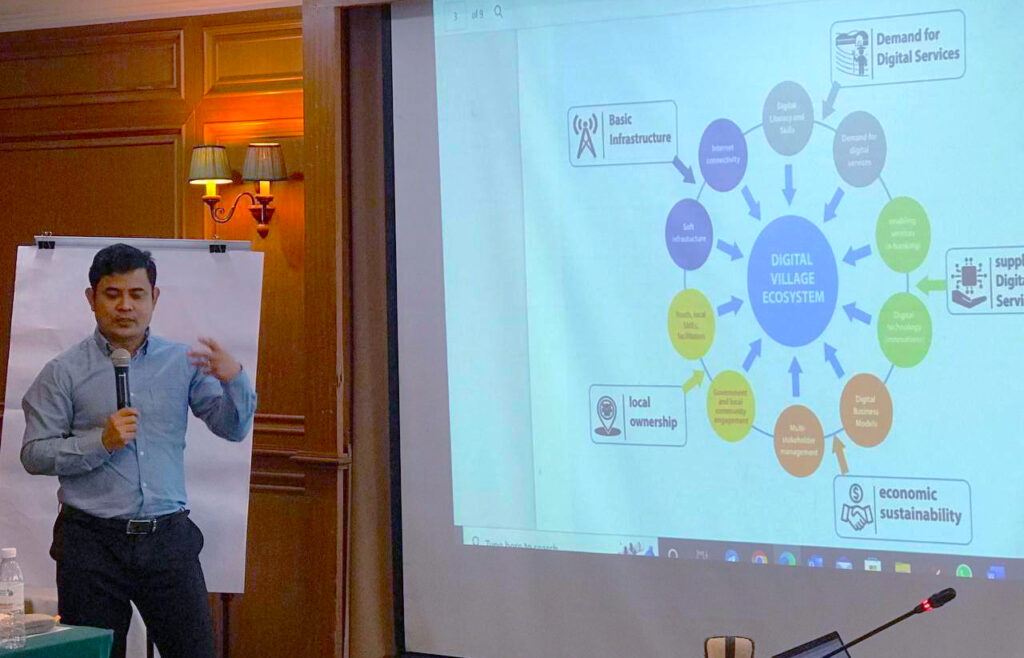
“Our network has shown high resiliency during the difficulties amidst the pandemic, a test of our
solidarity and strength through diverse
activities that we are doing for the region”
Dr. Nguyen Xuan Hong
(AsiaDHRRA, Chairperson)
DHRRAs in Focus
In brief, here are some of their notable milestones.
CamboDHRRA
They have increasing memberships from national farmer organizations, local and international civil society organizations (CSOs), and the private sector. Additionally, they now have full-time staff and clear personnel policies to mobilize more resources, build partnerships, and organize multi-sector engagement and workgroup meetings.
LaoDHRRA
LaoDHRRA made full use of both financial and technical resources from the regional RAI project allowing them to build their capacity building in rolling out Responsible Agricultural Investment (RAI) among partners. Workshops and case studies concerning policy advocacy were implemented effectively with support from experts on capacity building. LaoDHRRA’s activity implementation managed to get support from the Lao government with many members of their Management Board Committee have good relations with the public sector.
MyanDHRRA
In 2021, MyanDHRRA had to deal with the negative impacts of the political turmoil in the country, the Covid 19 pandemic and the continuing impact of climate change. Amid these constraints they had to find ways to keep track of their work with partner FOs in three states, all engaged in different ways in sustainable farming, marketing, and policy advocacy. There had been difficulty in participating in regional programming of AsiaDHRRA due to the political condition but where there was opportunity for learning, MyanDHRRA actively participated virtually. .
ThaiDHRRA
ThaiDHRRA clarified their organizational structure and elected a new set of officers, bringing in at least 70% young generation in the new committee. ThaiDHRRA also collaborated with the government in some projects and conducted activities supported by the AsiaDHRRA in relation to the shared goal of empowering rural people’s organizations.
VietDHRRA
VietDHRRA strategizes to build the capacity of leaders and members in the network and strengthen their roles in activity coordination, education, and language skills to carry out development programs in rural areas. It is proposed to create an organizational database to highlight program and project implementation, cooperation, sharing experiences, and featuring VietDHRRA members’ and partners’ profiles.
Bina Desa (InDHRRA)
Bina Desa identified several factors to scale up their maturity level and plans for growth supported by the organization’s strength and using innovative approaches leading to the current changes reflected. Activities on research and education on Musyawarah for Bina Desa have used an online media approach to work and collaborate and have been adopted since the pandemic. They strategized working with academic and research institutions to address issues and re-educate intellectuals in their community, focusing on mentoring second-liners. In addition, participatory capacity-building programs were conducted for the staff relating to their job description.
PhilDHRRA
PhilDHRRA’s Strategic plan revolves around asset reform integration, agricultural productivity, and natural resource management for resilient, safe, and sustainable communities. The secretariat and network members implemented projects to promote peacebuilding, participatory, and good governance approaches in a local setting. As a result, members have established experience and track record in project implementation.
TaiwanDHRRA
During the pandemic, many of their agriculture extension-related works have been conducted virtually, thus, has provided more opportunities to engage in meetings. More connections and academic linkage points were made, including their university (NPUST) reach to Africa. In addition, their university is focused on synergizing the achievement of SDGs through green initiatives, like waste management, reduced packaging, and recycling. An example is a farm waste project where cacao shells can be used as charcoal to enhance soil conditions but can also be transformed into fish/shrimp feed.
DHRRA Reports
“The fair use of Musyawarah is everywhere in the DHRRA, and if we go to the rural people, it’s how we talk freely and strengthen our solidarity because the challenges are the same.”
Dwi Astuti
(Executive Director, BinaDesa,)
Financials
AsiaDHRRA Comparative Financial Report
2020-2022
Comparative Revenues
in Euro
Comparative Revenues per Project
in Euro
Comparative General Breakdown of Expenses
in Euro
Comparative Direct Program Expenses
in Euro
Figures are based on audited financial statements and are available on request
Governance
The ExeCom/Board met at least twice a year in the past two years, with the able leadership of Dr. Hong, AsiaDHRRA Chairperson. In between meetings, the Secretary General consulted the Chairperson and members of the Board bilaterally and as needed. Where there is opportunity bilateral in-person meetings were held back project visits to optimize travel cost e.g. in Phnom Penh, Hanoi, and An Giang where Board Members are. Some of the Board Members were able to represent AsiaDHRRA in key regional meetings, in particular those organized by the ASEAN Secretariat and SOMRDPE.
As a preparatory activity to the General Assembly, three (3) Sub-regional Consultations (Mekong sub-region, North DHRRAs, Southeast) were conducted where member DHRRAs did not only share their respective organizational growth status and development plans, they also discussed priority areas of concern at the sub-regional level. This effort was also linked to the agenda of reviving sub-regional cooperation to provide additional space for interaction among the members.

Executive Committee Meeting with staff observers
The Secretariat

Contact Us!
Be a partner with us in empowering smallholder-family farmers and in building resilient rural communities in Asia
AsiaDHRRA
Room 201 Partnership Center
59 C. Salvador St., Loyola Heights 1108,
Quezon City, Philippines
Telefax (632) 436-4706
- An affiliate of ASEAN
- An NGO in Special Consultative Status with the Economic and Social Council of the United Nations (ECOSOC)
- A member of AgriCord
- Member of World Rural Forum
